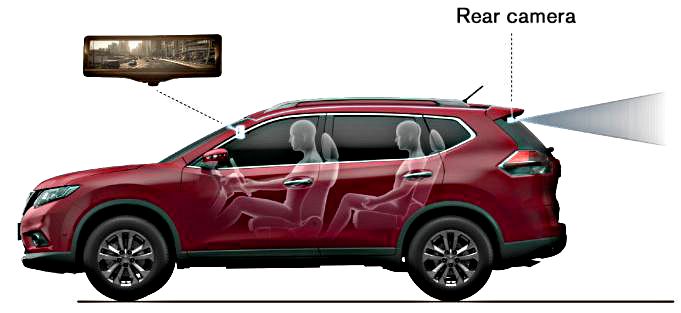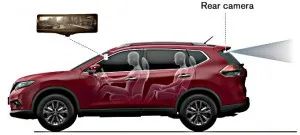A new-to-me display application was reported in the news during this past week. It is an improvement to the conventional automotive rear view mirror. The need for an improvement can be illustrated by offering two familiar examples.
- One: while driving in the dark, bright headlights from a car behind yours are reflected into your eyes by the rear view mirror. Even if not blinded, you still cannot make out any details of the road behind your car.
- Two: the back seat of your car is filled with objects or people and your view through the back window is obstructed. In both cases, the rearview mirror is not providing you with a useable view of the scene behind your car.
To help deal with such situations, Nissan Motor Company, Ltd. (Yokohama, Japan) has developed a so-called Smart Rearview Mirror.
In this system, the conventional rearview mirror has been replaced by one that can be switched between a view produced by a normal mirror surface and a view presented on an electronic display. In the electronic display mode, video is presented on a LCD that is in the shape of a rear view mirror and that is fed by a camera installed at the rear of the vehicle.

Switching between the normal mirror and camera view modes requires the driver to flip the equivalent of the dimmer switch, the kind that is usually used to change the mirror view from daytime to nighttime driving. It is reported that, after flipping the switch, it takes about two seconds for the video feed to begin.
To ensure that the video is crystal clear, image processing capability is built-in to the Smart Rearview Mirror module. Given this capability, the video presented to the driver can be composed of near simultaneous, multiple exposures allowing creation of a high dynamic range image. As a result, extra image brightness can be made available during night time and other low-light driving conditions. The camera is also able to enhance the rear view image quality in stormy weather, rain or snow, in the glare of direct sunlight, during sunrise or sunset conditions or when your vehicle is being followed by a vehicle with powerful headlights. In addition, the position of the camera eliminates blockages from the car’s interior providing a clear view of the scene behind your vehicle.
Nissan’s Smart Rearview Mirror capability will be available to the driver on-demand. That is, at any time. This may actually present a problem in that current US laws prohibit video to be visible to the driver when the vehicle is moving.
It is interesting to note that matching a standard wide angle camera lens to the rearview mirror was not trivial. There are two related reason for this situation. First, conventional LCDs have an aspect ratio of 4:3 or 16:9. Unfortunately, a display with such a shape is not suitable for use as a rear view mirror. It was, therefore, necessary to develop an LCD with an aspect ratio of approximately 4:1. Again, unfortunately, when the image produced by a standard wide angle camera lens is adjusted to a LCD having such a shape, the result is a low resolution image with poor picture quality. The solution to this problem was to develop a 1.3 megapixel narrow-angle camera. By doing so, good picture quality was achieved when the video was presented on the specially designed LCD.
An interesting aspect of the Smart Rearview Mirror is that it provides a wider viewing angle than a standard rear view mirror.
The normal field of view of a rearview mirror is about 17 degrees, while the new camera expands coverage to about 48 degrees. The difference was immediately apparent to an early reviewer that reported “just backing out of my driveway – instead of having to turn my head to fill in the gaps between the mirrors, I could just see a fair amount of the street without shifting my viewpoint.” He went on to state that “It does take some getting used to though – since the camera is right at the back of the car, everything is suddenly close up instead of 5 to 6 feet in the distance. When you’re stopped in traffic it means suddenly getting very familiar with the car behind you, and depending on the height and zoom (which are adjustable) you might be able to see all of it in the 4:1 aspect ratio mirror.” The report concluded by stating that “The digital view on the LCD screen was clear with only the tiniest bit of digital blur when the view moved quickly horizontally when you were making a turn.”
Nissan plans to offer the Smart Rearview Mirror as a stand-alone feature and will likely be available for most vehicles. The add-on price appears to be in the range of about $600. –Arthur Berman

